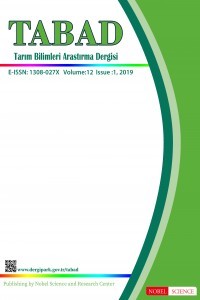A General Discussion on Green Tobacco Sickness in Tobacco Producers Living in Manisa Province
Green Tobacco Sickness, Oriental Tobacco, Nicotine, Manisa
___
- Anonim, (2012). Tütün ve Alkollü İçkiler Piyasası Düzenleme Kurumu. www.tapdk.gov.tr
- Anonim, (2013a). Citta del Tobacco. http://www. cittadeltabacco.it/en/tobacco-types
- Anonim, (2013b). Tütün ve Alkollü İçkiler Piyasası Düzenleme Kurumu. www.tapdk.gov.tr
- Arcury TA, Quandt SA, Preisser JS, Norton D. (2001a). The incidence of green tobacco sickness among Latino farmworkers. J Occup Environ Med 43:601–609.
- Arcury TA, Quandt SA, Preisser JS. (2001b). Predictors of incidence and prevalence of green tobacco sickness among Latino farmworkers in North Carolina, U.S.A. J Epidemiol Community Health 55:818–824.
- Arcury TA, Quandt SA. (2006). Health and social impacts of tobaccoproduction. J Agromedicine 11:71–81.
- Arcury TA, Vallejos QM, Schulz MR, Feldman SR, Fleischer AB Jr, Verma A, Quandt SA. (2008). Green tobacco sickness and skin integrity among migrant Latino farmworkers. American Journal of Industrial Medicine 51(3):195-203.
- Ballard T, Ehlers J, Freund E, Auslander M, BrandtV, HalperinW. (1995). Green tobacco sickness: Occupational nicotine poisoning in tobacco workers. Arch Environ Health 50:384–389.
- Curwin, BD, Hein, MJ, Sanderson, WT, Nishioka, MG, Buhler, W. (2005). Nicotine Exposure and Decontamination on Tobacco Harvesters’ Hands. Ann. occup. Hyg., Vol. 49, No. 5, pp. 407–413. Published by Oxford University Press.
- Çiçek, A ve Erkan O. 1996. Tarım Ekonomisinde Araştırma ve Örnekleme Yöntemleri. GOÜ Ziraat Fakültesi Yayınları No:12. Ders Notları Serisi No:6, s:58-73. TOKAT.
- D’Alessandro A, Ben owitz NL, Muzi G, Eisner MD, Filiberto S, Fantozz P, Montanari L, Abbritti G. (2001). Systemic nicotine exposure in tobacco harvesters. Arch Environ Health 56:257–263.
- Gehlbach SH, Williams WA, Perry LD, Woodall JS. (1974). Greentobacco sickness: An illness of tobacco harvesters. JAMA 229:1880–1883.
- Gehlbach SH, Williams WA, Perry LD, Freedman JI, Langone JJ, PetaLV,Woodall JS. (1975). Nicotine absorption by workers harvesting green tobacco. Lancet 305(7905):478–480.
- Gehlbach SH, Williams WA, Freedman JI. 1979. Protective clothing as a means of reducing nicotine absorbtion in tobacco harvesters. Arch Environ. Health, 34(2): 111-114.
- Ghosh SK, Parikh JR, Gokani VN, Kashyap SK, Chatterjee SK. (1979). Studies on occupational health problems during agricultural operation of Indian tobacco workers. J Occup Med 21:45–47.
- Karafakoğlu YS. (2004). Tütün Çalışanlarında Oksidan- Antioksidan Durum. Kocatepe Tıp Dergisi (The Medical Journal of Kocatepe). Cilt 5 No:2 Sy.7-10
- Kevseroğlu K. (2000). Tütün Ürünleri Üretim Teknolojisi. OMU Bafra Meslek Yüksekokulu Yayınları No:3. Bafra-Samsun.
- Kınay A. (2010). Tütünde (Nicotiana tabacum L.) Farklı Azot Dozlarının Verim ve Kalite Özelliklerine Etkileri. Gaziosmanpaşa Üniversitesi Fen Bilimleri Enstitüsü, Tarla Bitkileri Anabilim Dalı. Yüksek Lisans Tezi. Tokat.
- McBride J, Altman D,Klein M, White W. (1998). Green tobacco sickness. Tobacco Control. 1998 September; 7(3): 294–298.
- Misumi J, Koyama W, Miura H. (1983). Two cases of ‘‘green tobacco sickness’’ in the tobacco harvesters and the absorption of nicotine through the skin in the rat. Sangyo Igaku 25(1):3–9.
- Parikh JR, Gokani VN, Doctor PB, Kulkarni PK, Shah AR, Saiyed HN. (2005). Acute and chronic health effects due to green tobacco exposure in agricultural workers. Am J Ind Med 47:494–499.
- Trape´-Cardoso M, Bracker A, Grey M, Kaliszewski M, Oncken C,Ohannessian C, Barrera LV, Gould B. (2003). Shade tobacco and green tobacco sickness in Connecticut. J Occup Environ Med 45:656–661.
- Quandt SA, Arcury TA, Preisser JS, Bernert JT, Norton D. (2001).Behavioral and environmental predictors of salivary cotinine in Latino tobacco workers. J Occup Environ Med 40:844–852.
- Weizenecker R, Deal WB. (1970). Tobacco cropper’s sickness. J Fla MedAssoc 57(12):13–14.
- Başlangıç: 2008
- Yayıncı: Nobel Bilim ve Araştırma Merkezi Limited
Gastronomik Ürünlerin Coğrafi İşaretleme Açısından Değerlendirilmesi: Erzurum-Olur Örneği
Tülay POLAT ÜZÜMCÜ, Ömür ALYAKUT, Simay FERELİ
Nalan YILDIRIM DOĞAN, Hüseyin BULUT
Fertilizer and Pesticide Preferences of Rice Producers in İpsala District: An Economic Survey
Tuna ŞENER, İpek ATILGAN HELVACIOĞLU, Cem TOKATLI, Alpay BALKAN
A General Discussion on Green Tobacco Sickness in Tobacco Producers Living in Manisa Province
Sıdıka EKREN, Dursun KURT, Ahmet KINAY, H. Vakıf MERCİMEK
Ökseotu (ViscumAlbum L.)’nun Sarıçam Odununun Bazı Mekanik Özelliklerine Etkisi
Hatice ULUSOY, Nurgül AY, Hüseyin PEKER
Rize İlinden Toplanan Yerel Fasulye Genotiplerinin Tohum Özelliklerindeki Varyasyon
Arzu KARATAŞ, Damla TURAN BÜYÜKDİNÇ, Sonay BİLGİLİ, Ş. Şebnem ELLİALTIOĞLU
AntibacterialPotential of Hypericumcalycinum L.from Turkey
Karyotype Analysis Of Fennel (Foeniculum vulgare Mill.) From Ankara Province
